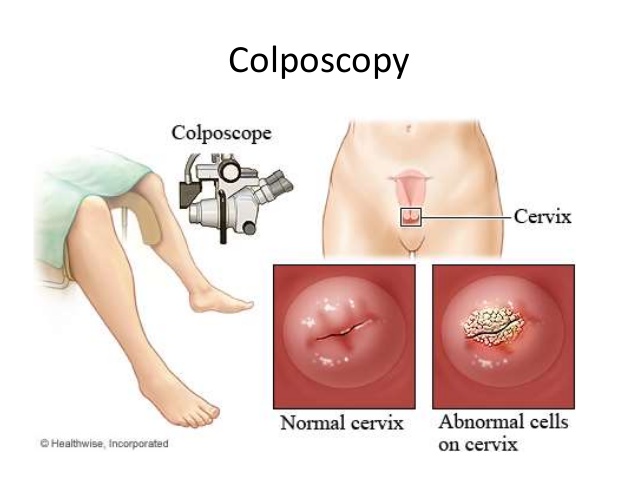
What is a colposcopy?
A colposcopy is a close examination of a woman’s cervix (or neck of womb) using a special microscope called a colposcope. The colposcope can be used to examine for abnormal cells in the woman’s genital tract including cervix, vagina and vulva.
What preparation is needed before colposcopy?
Colposcopy cannot be performed while you are having your period. Some women experience cramping (like period pains) during the colposcopy. You may find it helpful to take a painkiller an hour before the procedure to minimise discomfort.
You may be recommended to have a colposcopy after an abnormal Pap smear or due to symptoms such as bleeding from the cervix.

How is colposcopy done?
- First a speculum is inserted into vagina.
- Pap smear is taken.
- The colposcope is placed at the entrance to the vagina. The doctor then looks at the cervix through the colposcope. The colposcope magnifies the cervix 15-30 times.
- A weak vinegar solution is then applied to the cervix. Areas where there are changes in the cells turn white. Healthy cells stay pink.
- If the cervical tissues stain white, then the doctor may perform a biopsy (removal of tiny pieces of tissue) from any areas of concern.
- Biopsies generally are not painful. The tissue collected is sent to a laboratory for testing to determine if treatment is necessary.
- Sometimes a brown solution (Iodine) is applied to view your cervix. You need to tell the doctor or nurse if you are allergic to iodine.
What should I do after the procedure?
- Wear a pad for a few days to prevent staining of your underwear by iodine solution.
- Avoid heavy physical exercise after a biopsy, swimming, bathing or penetrative sexual intercourse for about a week.
- If a biopsy is taken, some extra discomfort may be experienced for a short time.
- Please contact your doctor if you have any heavy bleeding, fever or offensive vaginal discharge.
Obtaining results, follow up care and referral.
It is important that you see the doctor for follow up care after the colposcopy. At this visit the doctor will explain what was seen and how you will get your results.

Depending on your results, the doctor may recommend:
- more frequent Pap smears
- repeating colposcopy for follow-up
- or, other treatment.
What treatments are available?
Your treatment will depend on whether an abnormality was detected and if so, the type of abnormality detected. Changes in the cells are treated by removing them. Follow up appointment will be arranged and the doctor will discuss further treatment options with you.
Common types of treatment
-
- LLETZ (large loop excision of the transformation zone) – A hot wire loop to remove the abnormal cells

-
- Cone Biopsy – A small cone shaped area of cervix containing the abnormal cells is removed surgically under general anaesthetic

Looking after yourself
It is important that you discuss your follow up with the gynaecologist before going home.
- You will have some bloodstained discharge for a couple of days, followed by spotting which may last for a couple of weeks. It is best to wait until the spotting has stopped before you resume sexual intercourse.
- You will probably be advised to have a Pap smear and possibly another colposcopy in six months time.
- Having regular Pap smears in the future is very important to maintaining your health.
For more information and advice
Dr Donald Angstetra is a Certified Colposcopist of the RANZCOG Colposcopy Quality Improvement Program (C-QuIP).
